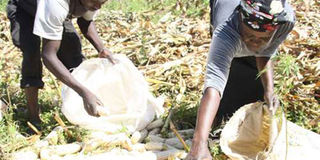Experts warn of looming maize shortage in Western

Rose Jahenda (right) and her son Boaz Muyanga put maize into sacks after harvesting at their farm in Nangili in Uasin Gishu County on October 15, 2012. Agriculture experts have said an acute shortage of maize could hit several parts of western Kenya. PHOTO | JARED NYATAYA | NATION MEDIA GROUP
What you need to know:
- Dr Simon Wesechere, director of Rural Information on Agriculture and Development Centre, attributed the looming shortage to erratic weather.
- There have also been challenges in Trans Nzoia county which has been a major maize producer in the region.
- Most of the crops which were planted much later than March have been starved of water and therefore affected normal maize development.
- Poorly spread rains has made it difficult for the crop to flower uniformly causing delay in formation of fruits.
An acute shortage of maize could hit several parts of western Kenya, agriculture experts have said.
Dr Simon Wesechere, director of Rural Information on Agriculture and Development Centre, on Wednesday attributed the looming shortage to erratic weather.
He said production could fall by over 50 per cent in both Busia and Kakamega counties.
There have also been challenges in Trans Nzoia county which has been a major maize producer in the region.
Dr Wesechere said most of the crops which were planted much later than March have been starved of water and therefore affected normal maize development.
“The reason why most crops appear stunted is because of the poor rains being experienced in the affected areas,” said Dr Wesechere.
He said poorly spread rains had made it difficult for the crop to flower uniformly causing delay in formation of fruits.
Maize farmers have expressed fears of running into heavy losses this season due to poor rains causing crops to wilt.
WITHSTAND DRY SPELLS
“For us who planted quite late is very challenging because we don’t know if we will be able to harvest anything,” said Ms Mary Wekesa, a maize farmer in Lugari.
She challenged seed companies to begin research on maize varieties that can withstand longer dry spells to cushion farmers from losses that might be incurred due to changes in rainfall patterns.
Some farmers thought they bought the wrong seeds or fertilizers.
Busia County Executive member for agriculture Moses Osia said a significant portion of the crop had been completely destroyed. The worst hit parts are Budalang’i and Funyula constituencies.
“We are taking necessary steps as a county government to cushion locals from a possible food shortage,” he said.
He said production in the area was bound to hit a 30 per cent low as a result of poor rains.
He noted that the farmers can compensate for the losses by planting maize a fresh during the short rain season.
Farmers in Kakamega produce two million bags of maize annually against a demand of four million.




